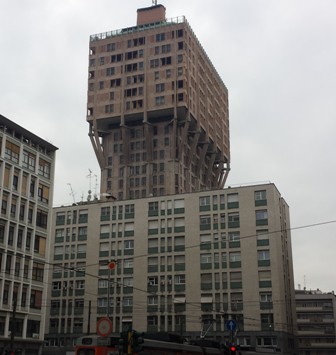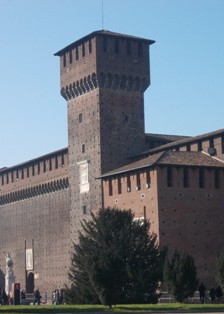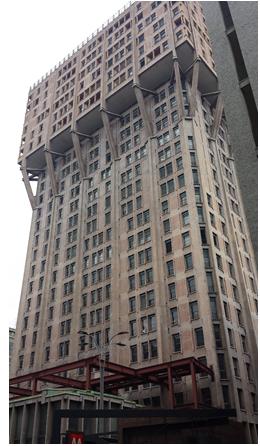The Ugliest Buildings in the World
Just as in other creative fields, architecture has its own rankings – not only for the most outstanding and beautiful buildings but also for those considered the most awkward, the ugliest, and the greatest professional blunders. Naturally, this does not apply to insignificant countryside houses with Alpine roofs and marble lions at the entrance, but rather to buildings whose significance, location, and monumental presence make them worthy of inclusion on such a list in the first place.
The selection is, of course, highly subjective and often controversial, which is why some buildings deemed architectural masterpieces by some end up on lists of the world’s ugliest structures. Take, for example, Orson Welles – the legendary filmmaker – who once lamented that stray bombs during the Spanish Civil War had failed to destroy Barcelona’s Sagrada Família, a building he regarded as the ugliest building ever constructed. Welles, it seems, remained alone in that opinion. On the other hand, a far greater number of people have voiced similar sentiments about the Centre Georges Pompidou in Paris. This structure, with its stark contrast to the romantic surroundings of the historic Beaubourg district, has occasionally been included among the worst architectural offences in history. And yet, as we know, many others see it as a ground-breaking milestone in contemporary architecture. Likewise, the works of Frank Gehry are often listed both among the most beautiful and the most hideous buildings in the world. What, then, should be said of the headquarters of China Central Television, designed by Rem Koolhaas? Lauded by the architectural profession and recipient of prestigious awards, this building is often derisively nicknamed “the boxer shorts” by Beijing’s residents, with some even claiming to see suggestive imagery in its shape.
Overall, contemporary lists of the world’s ugliest buildings tend to be disproportionately filled with brutalist structures – something that primarily reflects the public’s current attitude towards this architectural style. Notably absent from these rankings, however, are the significant brutalist buildings of Skopje, known as the “brutalist capital of the world.” This omission is largely due to the skill of the leading Macedonian architects involved in the city’s post-earthquake reconstruction, who successfully navigated the then-prevalent architectural expression. However, such an argument cannot be made for the most brutalist of all Skopje’s brutalist buildings – the University of Saints Cyril and Methodius – which, fortunately, is well hidden behind dense vegetation, making it difficult to spot and thus saving it from an unflattering nomination. As long as the greenery around the university remains thick enough, the dubious honour of being our region’s only representative among the world’s ugliest buildings will continue to rest solely with the National Library in Pristina, whose most distinctive feature is the peculiar “cauliflower” domes adorning its flat roof.
Despite the subjectivity of such rankings and the diversity of human tastes, some structures are almost impossible to omit from lists of the world’s most unsightly buildings. Among these are the massive, pyramid-shaped Ryugyong Hotel in Pyongyang, the Elephant Building in Bangkok (which, as its name suggests, resembles an elephant), and the Longaberger Basket Company building in Ohio (designed to look like a giant wicker basket). Somewhat unexpectedly, however, Italy also has a representative on these notorious lists: Milan’s Torre Velasca, Velasca Tower.
Torre Velasca
Given the inherent subjectivity and controversy surrounding such rankings, the selection of the world’s ugliest building is rarely more than a light-hearted entertainment. However, when the prestigious London-based Daily Telegraph published its list of the world’s ugliest structures – placing Milan’s Torre Velasca at the very top, ahead of the Ryugyong Hotel and the National Library in Pristina – Milanese architects found little amusement in the matter.
Judging by the article’s approach, the choice of buildings, the expertise of the authors, and the reasoning applied, it was evident that this was no casual jest – the British, on this occasion, were not joking. What had long been a lingering suspicion was now an official verdict, and appeals to the diversity of human taste were no longer a sufficiently convincing defence.

A hard pill to swallow for the proud Milanese. Good heavens – how could it be that a building from Caravaggio’s Milan, the city of Leonardo’s Last Supper, the world capital of fashion and design, a place that is, in our collective subconscious, the very embodiment of refinement and style, had landed at the top of the world’s ugliest buildings list?
But, enough lamenting – let’s try to find a rational explanation.
After World War II, Italy found itself in dire political and economic straits. However, with the backing of a powerful Western ally, the country overcame its war wounds after a few difficult years, setting the stage for a period of remarkable economic growth. Northern cities – Milan in particular – were at the forefront. By the 1950s, with Italy firmly on the road to recovery, the need arose for a striking symbol of progress. For Italians at the time – just as for today’s Chinese and Gulf nations – such symbols were first and foremost American-style skyscrapers.
A perfect opportunity to create such a symbol arose when Milan’s city authorities approved the construction of a 100-metre-high tower on Piazza Velasca, Velasca Square, right in the city centre, on a site left vacant by wartime bombings. The commission was awarded to BBPR, an esteemed Milanese firm that seemed the ideal choice.
At the time, BBPR’s leading figures were Lodovico Barbiano di Belgiojoso, Enrico Peressutti, and Ernesto Nathan Rogers – three prominent intellectuals from influential families, members of the global architectural elite, affiliated with the most prestigious international associations, editors of renowned architectural journals, and lecturers at top universities, including Princeton, Yale, and MIT. Since no details were ever disclosed regarding their individual contributions to the project, we can consider them equal authors of the design. Here’s how they reasoned: the tower’s location was deep in the historic core of the city, just half a kilometre from the Duomo. A glass-and-aluminium skyscraper in such a setting would have been an obvious visual assault on Milan’s old town and would not have fulfilled the requirement that this new Italian symbol be distinctly Italian. A more massive, solid construction was deemed more appropriate, allowing for better integration with the surrounding 18th- and 19th-century architecture. Moreover, a simple rectangular volume was considered too dull, so the architects sought a shape with historical precedent. Their inspiration was within arm’s reach – the towers of the Sforzesco Castello, Sforza Castle, Milan’s most significant historic landmark, offered exactly what they needed: a form that was both unmistakably Milanese and widely regarded as aesthetically pleasing.

Of course, the goal was never to literally replicate historic buildings but to reinterpret them in a contemporary way – especially in terms of structure. That is why the overhanging upper floors of the newly designed Torre Velasca were supported by massive concrete struts, a hallmark of 20th-century structural engineering that showcased the technical superiority of the modern age.

Every decision had a clear rationale, a solid justification, and an impeccably sound academic foundation. The result? A total fiasco.
At first, however, the failure was not acknowledged within professional circles. When the building was completed, its designers were even awarded Italy’s annual prize for the best architectural achievement. Some Milanese architects still refuse to admit defeat, describing the building as a “protest against international architectural norms”, “an inventive design and the first modern mushroom-shaped structure”, or “the pride of Milan, which has no interest in competing with other Italian cities for Renaissance grandeur.”
At least, that was the official narrative. Unofficially, however, the architects of Torre Velasca were never again entrusted with projects of similar prestige, and images of the building were conspicuously absent from campaigns promoting Italy’s economic miracle. Fortunately for Milan’s reputation, the same year – 1958 – saw the completion of the Pirelli Tower, a building that fully met the city’s ambitions. Its creators, Gio Ponti and Pier Luigi Nervi, went on to become global architectural stars, securing high-profile commissions, despite both being well into their seventies.
Later Impact on Architectural Thought
The failure of Torre Velasca had a profound effect on architectural thinking. Despite its academically sound rationale, the fiasco represented an architectural paradox that left designers deeply unsettled. How should one act when confronted with such a situation?
Even today in Milan, there are architects toying with the same idea. I don’t believe they aim to retroactively exonerate their predecessors; rather, they likely think that those early ideas were never fully explored. They argue that the concept should be revisited and refined a few more times – in the hope of eventually proving that the old masters were indeed on the right track.

However, some opted for an entirely opposite approach. About twenty years after the Torre Velasca episode, a group of architects, facing a similar dilemma, resolved the paradox in a radically different manner. They were Renzo Piano, Richard Rogers, and Gianfranco Franchini – the masterminds behind the Centre Georges Pompidou, envisioned as a modern art centre in the historic Beaubourg district of Paris. Fully aware of the Velasca debacle – Richard Rogers being a close relative of Ernesto Nathan Rogers, one of Velasca’s co-authors, and both Piano and Franchini having studied architecture in Milan during the tower’s construction – they knew exactly what not to do. Yet, they weren’t sure what they should do, so they decided to do the complete opposite of what their esteemed predecessors would have done.
They adopted an entirely unacademic approach, creating a building that completely disregarded its surroundings. They exposed all the service pipes and ducts – unnecessarily oversized, no less – on the façade, painting them in different colours to indicate water supply, air conditioning, sewage, fire hydrants, and so on. Unsurprisingly, the local grannies were in a state of utter despair, and the newspapers ran headlines about a new Parisian monstrosity. In short, everything was completely contrary to the initial official reactions to Torre Velasca. Although controversies persist to this day, over time, the building has been embraced by the public, and the professional community had been favourably inclined from the start.
Still, it’s better not to draw a general conclusion. Let’s imagine for a moment that the architects of the Centre Pompidou had attempted their approach in the heart of Milan, on Velasca Square, in place of the current tower. I’m not entirely sure they would have made it out alive.
Look on the Bright Side
Having seen some of the buildings featured on various “ugliest in the world” lists, I’d like to take a more optimistic view – especially when considering the impact these structures have on their surroundings.
A quarter of a century ago, Pristina was a city of utterly bland, uninspiring buildings. In that sea of architectural nothingness, the National Library was the only structure that even stood out – and in a way, that was refreshing. The “cauliflowers” on its roof? They’re actually skylights, designed to bring much-needed diffused daylight into the reading rooms.
The headquarters of China Central Television (CCTV) sits in Beijing’s business district, surrounded by conventional, well-designed, international-style skyscrapers that could just as easily be in Hong Kong, Atlanta, or anywhere else – and would be utterly unremarkable. It is the CCTV building, with its striking and unconventional form, that lends character and charm to the entire district and enhances the aesthetic appeal of every neighbouring structure.
I hate to say it, but Mr Welles was seriously mistaken – Sagrada Família doesn’t just adorn Barcelona’s skyline; it makes the city seem a bit like a fairy tale.
As for the Centre Georges Pompidou – yes, indeed, it clashes with its surroundings. So what? Paris still has a number of traditional quarters left untouched, and we can admire them to our heart’s content. Let’s be honest – without the Pompidou, the Beaubourg district and its buildings would have gone largely unnoticed. The stark contrast is precisely what gives the area its distinct charm.
Unfortunately, finding something truly praiseworthy to say about Milan’s Torre Velasca is a bit more challenging. At the very least, it was an honourable architectural endeavour. Perhaps we can at least appreciate that.
Darko Veselinović
January 2017



